PLEASE NOTE: The information in this blog is for educational purposes only. It is not a substitute for professional medical advice. Consult your healthcare provider if you’re seeking medical advice, diagnoses, or treatment.
It’s easy to look at items in the grocery store and think that the differences between products stop at price and packaging. Sadly, this is often not the case.
Meat is no exception!
In particular, grass-fed vs grain-fed beef is a common decision for meat eaters.
Grass-fed beef has been steadily gaining popularity in the United States.
In 2012, retail sales of grass-fed beef were $17 million. This number increased to $480 million in 2019 (1).
Increased interest in grass-fed beef comes from potential health benefits, animal welfare, and the geographical origin of the meat (2).
But is grass-fed beef worth it? Or is it another marketing tactic?
Let’s find out!
Beef Labels are Confusing!
Don’t you wish food labels were more user-friendly? Whether it’s intentional or not, finding high-quality beef can be a confusing task.
Here are some terms you’ll see in this article as well as on beef packaging:
Pasture-raised is defined by the American Grassfed Association as animals raised on pasture without confinement (3).
Grass-finished cows eat nothing but grass and forage before processing. They also consumed milk before weaning.
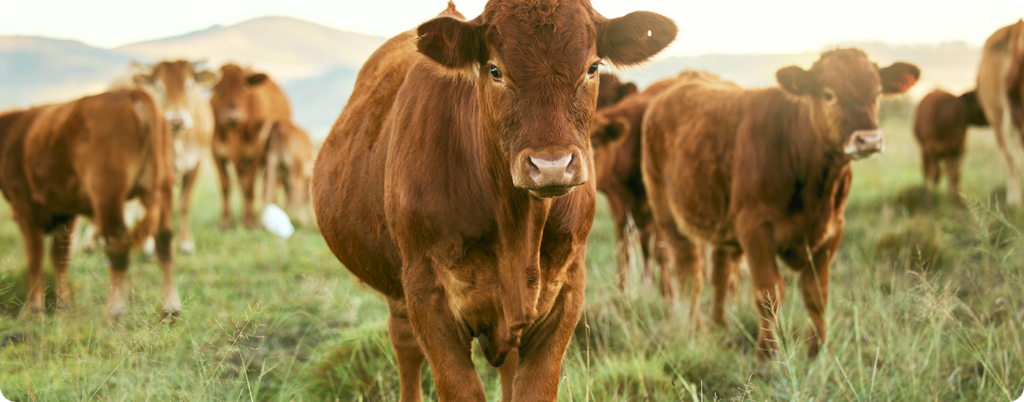
Most beef originated from grass-finished cattle until the 1940’s (4).
Research in the 1950s led to the development of the feedlot industry (more on this later), which now dominates beef production.
Grass-fed cows eat grass at some point throughout their lives. This does not mean they’re only fed grass.
They may primarily eat grass, then move to a grain-based diet prior to harvest. Some grass-fed cattle also receive supplemental grain feed at various points in their lives.
Grass-fed cows can still be raised in feedlot environments with grass pellets (5).
So, you may be spending more on grass-fed beef, which may not be warranted!
Until recently, cattle could be imported from other countries, inspected in the United States, and slapped with a label that says “Product of the USA.”
If you’re confused, you’re not alone!
One of the best ways to cut through the noise is to connect with local farmers. You can easily find clarity on feed quality, animal welfare, and other relevant information.
Going Beyond Grass-Fed Beef
As you can see, the grass-fed label is misleading in some instances.
So, what should you look for when buying beef?
There’s no one right answer, but the highest quality beef will generally contain some combination of these terms:
100% Grass-Fed & Finished
Pasture Raised
Regeneratively Raised
Antibiotic & Hormone Free
Organic
Looking for these terms can ensure that you’re consuming a product that’s nutritious and prioritizes the health of the animals.
Here are some online retailers that serve as helpful references.
- White Oak Pastures
- Verde Farms
- Wild Pastures
- Carter Country Meats
- Nose to Tail
- TruBeef Organic
- Perennial Pastures Ranch
- Wild Meadows Farm (for the Canadian folks)
Again, you can also find local farmers who produce beef with these standards in mind!
Is It Healthy to Eat Grain-Fed Beef?
It’s still possible to find high-quality beef that has been fed grains!
You can have an animal that spent the bulk of its life munching on grass in wide open spaces, but it received a small amount of grains towards the end.
Regardless, beef is still an incredible source of bioavailable protein, iron, selenium, zinc, and other essential nutrients (6).
The main idea is to avoid animals that have primarily eaten grains.
These animals usually come from feedlots.
The Problems With Feedlot Beef
Most beef from the supermarket comes from concentrated animal feeding operations (CAFO), otherwise known as feedlots.

CAFOs are large-scale productions that aim to mass-produce meat at the lowest possible cost.
This generally means that animals are in confined spaces, given low-quality inputs and growth hormones.
An estimated 96% of ruminant livestock in the US go to feedlots (7)!
Rather than having room to graze, cattle are kept in small pens, often covered in excrement. Cows are ruminant animals meant to eat grasses and perform better when offered a variety of plants (8).
Despite this, feedlot cattle are often fed genetically modified soy and corn to increase their size and marbling while minimizing costs.
Unsurprisingly, cattle in feedlots are often stressed, unhealthy, and require antibiotics (9). Estimates suggest that 50-80% of the antibiotics administered worldwide are for livestock production.
These antibiotics are used to treat and prevent disease and enhance the animals’ growth (10).
Antibiotic usage in animals can directly impact human health.
Overuse of antibiotics in feedlots is a known contributor to the global health challenge of antibiotic resistance (11). Some infections are more difficult to treat as antibiotics lose efficacy (12).
Feedlot beef is much more affordable, but its true price is less evident.
You’re likely consuming an animal pumped full of antibiotics, growth hormones, and genetically modified feed, which may negatively impact your health.
Livestock are sometimes fed skittles that aren’t fit for sale (including the wrappers in some instances)!
Grass-Fed vs Grain-Fed Beef: Important Differences to Consider
It’s often said that there’s little to no nutritional difference between grass-fed and grain-fed beef. New insight is emerging that challenges this notion!
Here are some relevant differences to consider between grass-fed and grain-fed beef.
1. Omega 6 to Omega 3 Ratio
Polyunsaturated fatty acids (PUFAs) like omega 3’s and omega 6’s (crucial to our health) cannot be made in the body and must be obtained through food.
Historically, humans consumed an omega-six to omega-three ratio of around 4:1 or less (13).
Modern diets, on the other hand, often contain 10-20 times more omega six than omega three.
This is largely due to the consumption of ultra-processed foods with unnaturally high levels of linoleic acid (a type of PUFA). Excess linoleic acid can damage mitochondria, leading to inflammation and chronic disease (14).
In particular, seed oils like canola, safflower, sunflower, and soybean contain an unnaturally high amount of polyunsaturated fatty acids.
Cattle primarily fed grass generally have higher levels of omega 3’s and a more ancestrally consistent omega-6 to omega-3 ratio (15).
Several studies have shown that the ratio for grass-fed beef hovers around 2:1 (16).
Grain-fed cattle tend to have higher levels of omega-6 due to corn and soy intake.
2. Phytonutrients
Part of the magic of cattle is that they can convert grasses inedible to humans into nutritious meat.
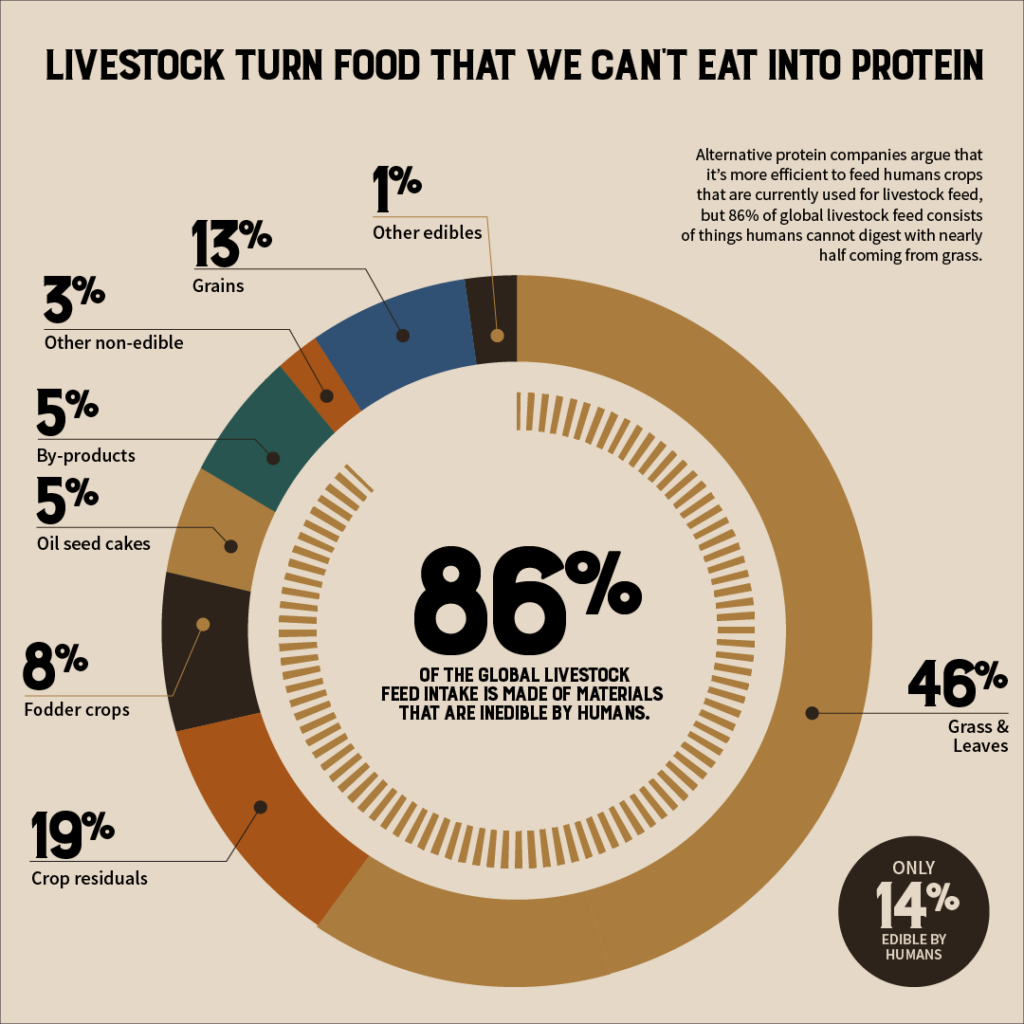
New data indicates that phytonutrients (also known as phytochemicals or anti-oxidants) can accumulate in meat and milk when cattle consume different plants on pasture (17).
Animal health can improve by eating mixtures of grasses, shrubs, and trees rich in phytochemicals (18). Phytochemical concentrations are frequently undetected in animals given grain-based diets in feedlots.
3. Conjugated Linoleic Acids (CLA) Content
Conjugated linoleic acid (CLA) is an essential fatty acid found in ruminant animals that is being investigated for improvements in health challenges like obesity, inflammatory bowel disease (IBD), certain cancers, and cardiovascular disease (19, 20).
The CLA content of ruminant foods depends on factors such as feed type, seasonality, age, and breed of the animal (21).
Grass consumption helps foster a favorable rumen environment for CLA-producing bacteria.
Meat and dairy from ruminants raised on pasture are excellent sources of CLA (22, 23).
4. Fat Content
Any breed of grass-fed cattle has a lower total fat content than grain-fed animals (24).
Due to lower activity levels, grain-heavy diets, and the potential use of growth hormones, grain-fed cattle tend to hit the market faster and with more fat than grass-fed animals.
5. Vitamin & Mineral Content
Meat and milk are rich sources of protein, iron, zinc, vitamin B12, and selenium, regardless of how they’re raised.
But, a recent study showed critical differences between feedlot and pasture-raised beef’s vitamin and mineral content.
Grass-finished beef had about 2x as much riboflavin and 3x as much thiamine (vitamin B1)(25).
Numerous studies also suggest that grass-based diets may elevate precursors for vitamins A and E and glutathione (26). Each of these are powerful antioxidants that can help fight free radicals in the body.
It often flies under the radar, but meat contains vitamin C! Pasture-raised animals can lead to higher levels of this important vitamin (27).
6. Price
The vast majority of beef in the United States passes through the hands of four companies: Tyson, Cargill, JBS, and National Beef (28) who account for an estimated 70% of beef production in the US.
They can run much more extensive operations, prioritizing limiting space, reducing the cost of inputs, and getting cattle ready for slaughter in less time.
Price is often the deciding factor for individuals looking at grass-fed vs grain-fed beef.
Grass-fed beef is an estimated 47% more expensive than grain-fed beef and is generally produced on a much smaller scale (29).
However, it’s possible to drastically reduce the cost of grass-fed and finished beef by buying directly from farmers, buying in bulk, or taking part in a cow share.
Affordable grass-fed options are also popping up at stores like Walmart and Sam’s Club.
7. Environmental Impact
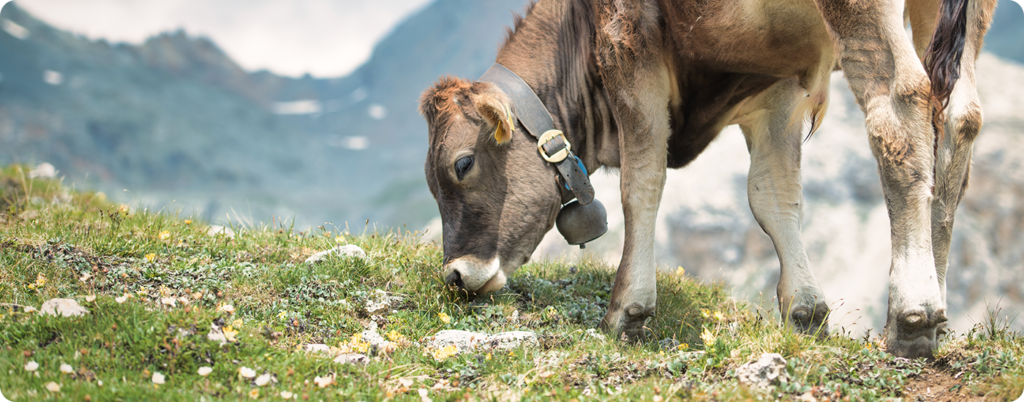
Grass-finished livestock can contribute to carbon sequestration, nutrient cycling, and clean water (30).
Regeneratively raised cattle (like those our supplements come from) can even be carbon-negative!
When managed improperly, agricultural and feedlot runoff can pollute public waters and air (31, 32, 33, 34). This can pose a risk to aquatic life and recreational and drinking water sources.
8. Toxin Exposure
Grain-fed cattle may be exposed to moldy feed (35, 36). Mycotoxins can develop at any stage (growing, harvesting, or storage) and in various environments.
Mycotoxins are fungal toxins found in mold spores and fragments. They can be ingested through food, air, or the skin.
Next, you’ve likely heard about glyphosate at some point.
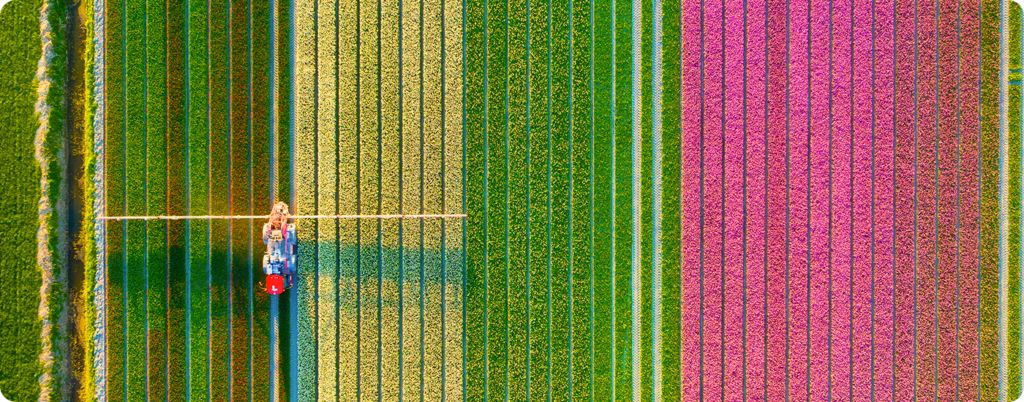
This herbicide is used globally on crops like corn, soy, and wheat (to name a few)(37).
Glyphosate is regularly applied to crops during the growing season, resulting in residues on livestock feed (38).
Glyphosate residues are also commonly detected in water, soil, and human urine (39). It can also accumulate in grains, leaves, and fruit.
Pastures generally aren’t sprayed with glyphosate as it kills growing grass (40).
Additionally, a significant amount of corn and soy fed to livestock is genetically engineered and sprayed with glyphosate (41).
Organic production practices prohibit herbicides like glyphosate, but organic products may still be exposed through runoff or spray drift.
Lastly, animals raised on diverse pastures need fewer antibiotics than those raised in feedlots or monoculture pastures (42).
As mentioned earlier, overuse of antibiotics in feedlots contributes to antibiotic resistance.
9. Glutathione Content
Glutathione is a powerful antioxidant that assists functions such as detoxification (43).
A study from 2021 found that grass-fed beef contained higher levels of glutathione (44). It is known that lush green forages can have elevated glutathione levels (45).
Grain-fed cattle will either not receive these or in smaller amounts.
10. Taste
Most Americans are raised on grain-fed beef, and people tend to prefer the taste of what they’re accustomed to (46).
So, many individuals find that grain-fed beef is tastier!
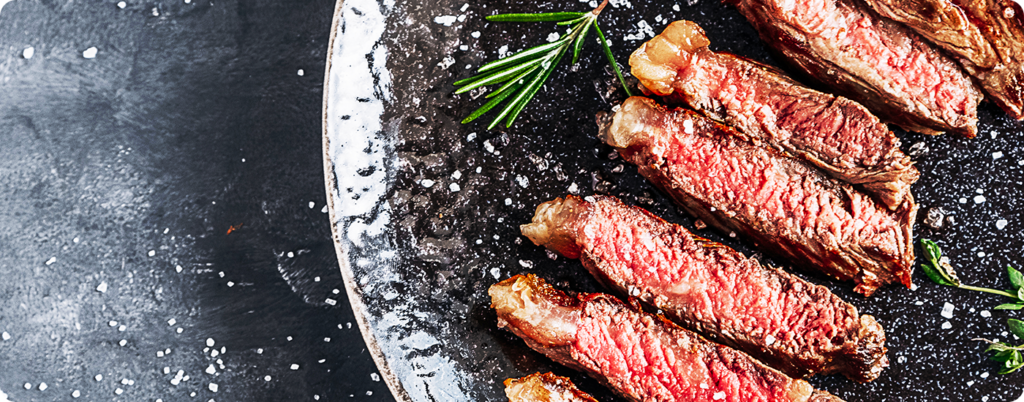
It’s important to know that grass-fed beef requires different cooking strategies due to its lower fat content. Grass-fed beef cooks faster and is ideal at rare or medium-rare temperatures.
If you’re eating steak, how you cut it matters too!
The Bottom Line on Grass-Fed vs Grain-Fed Beef
Meat labels nowadays can be incredibly confusing, and it’s tough to find answers at your local supermarket.
Grass-finished beef from a local farmer is ideal if you can afford it.
If not, look for locally raised beef, primarily fed grass that can roam freely.
It’s not the end of the world if cattle are given a small amount of grains before processing!
But do your best to avoid or limit beef from feedlots. These animals are often pumped full of antibiotics and low-quality feed.
If you want to truly understand where your beef comes from, how it was raised, and how it impacts the environment, look to forge a connection with local farmers!
Subscribe to future articles like this: